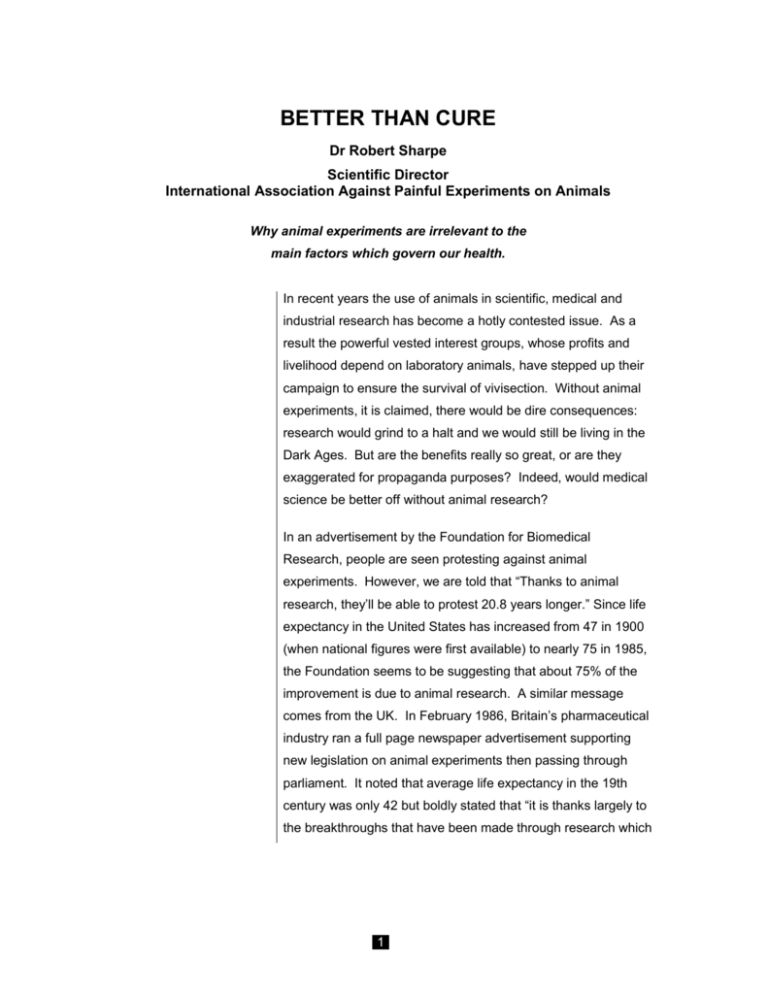better than cure - International Association Against Painful
advertisement

BETTER THAN CURE Dr Robert Sharpe Scientific Director International Association Against Painful Experiments on Animals Why animal experiments are irrelevant to the main factors which govern our health. In recent years the use of animals in scientific, medical and industrial research has become a hotly contested issue. As a result the powerful vested interest groups, whose profits and livelihood depend on laboratory animals, have stepped up their campaign to ensure the survival of vivisection. Without animal experiments, it is claimed, there would be dire consequences: research would grind to a halt and we would still be living in the Dark Ages. But are the benefits really so great, or are they exaggerated for propaganda purposes? Indeed, would medical science be better off without animal research? In an advertisement by the Foundation for Biomedical Research, people are seen protesting against animal experiments. However, we are told that “Thanks to animal research, they’ll be able to protest 20.8 years longer.” Since life expectancy in the United States has increased from 47 in 1900 (when national figures were first available) to nearly 75 in 1985, the Foundation seems to be suggesting that about 75% of the improvement is due to animal research. A similar message comes from the UK. In February 1986, Britain’s pharmaceutical industry ran a full page newspaper advertisement supporting new legislation on animal experiments then passing through parliament. It noted that average life expectancy in the 19th century was only 42 but boldly stated that “it is thanks largely to the breakthroughs that have been made through research which 1 requires animals that most of us are able to live into our seventies.” Foundation for Biomedical Research advertisement. Such propaganda is being challenged by medical professionals as blatantly misleading. In fact, it is not animal research but human studies to which we are chiefly indebted for the improvement in life expectancy. During the 19th century diseases which had plagued the human race for centuries still took a massive toll of victims. Epidemics of typhoid, tuberculosis, whooping cough, scarlet fever, diphtheria and many others were a feared and common occurrence. In developed nations like Britain and the United States, it was the virtual eradication of these infections that proved almost exclusively responsible for the decline in mortality and corresponding increase in life expectancy. And it is to social reformers such as Edwin Chadwick in Britain and Lemuel Shattuck in the United States that we owe the impetus to better health. (left) and Britain’s Edwin Chadwick championed public health © Bob Simms measures which virtually eradicated deaths from the common infectious diseases. 2 © Mary Evans Picture Library America’s Lemuel Shattuck By careful observation of different communities, they discovered that people who lived in dirty, overcrowded and unsanitary conditions with little food were much more likely to die of infectious disease. In 1850 Shattuck reported on the sanitary conditions in Massachusetts and revealed great inequalities in the life span between one social class and another.1 He concluded that life expectancy could be very much extended and general health improved by action directed towards sanitary reform, improvements in living and working conditions and other preventive measures. Shattuck argued that preventive measures would achieve infinitely more than remedies for the cure of disease. Chadwick’s observations had already led to similar conclusions and paved the way for the Public Health Act of 1848, the renaissance of public health in Britain.1 The resulting improvements in nutrition, hygiene and sanitation, and in living and working conditions, led to a rapid fall in death rates with mortality from virtually all the infectious diseases declining before, and in most cases long before, specific therapies or vaccines became available. In 1971 the president of the Infectious Disease Society of America, Edward Kass, stated that the decline of infectious disorders, correlated with improving socio-economic conditions, is “the most important happening in the history of the health of man.”2 In the United States for instance, tuberculosis mortality had already declined from nearly 200 per 100,000 of the population in 1900 to around 35 per 100,000 by the time streptomycin was introduced in 1947.3 And by the time chloramphenicol treatment became available in the late l940s, typhoid had been virtually eradicated.3 In Britain, around 90% of the reduction in deaths from the commonest infections of childhood - scarlet fever whooping cough, diphtheria and measles - had already been 3 achieved before the introduction of antibiotics and widespread immunization against diphtheria.4 In the 1860s the death rate Tuberculosis USA. The arrow marks the introduction of specific drug therapy. from whooping cough in England and Wales was over 130 per The decline in British mortality from measles, scarlet fever, diphtheria and whooping cough. time a nationwide vaccination program was initiated in the late 100,000 children but had fallen to around 0.5 per 100,000 by the © Lorraine Kay/Dr. Robert Sharpe © Lorraine Kay/Dr. Robert Sharpe 1950s.5 In an analysis of ten common infectious diseases, Boston University researchers John & Sonja McKinlay concluded that: “In general, medical measures (both chemotherapeutic and prophylactic) appear to have contributed little to the overall decline in mortality in the United States since about 1900 - having in many instances been introduced several decades after a marked decline had already set in and having no detectable influence in most instances.”6 The McKinlays found that medical measures (drugs and vaccines) only accounted for between 1% and 3.5% of the total decline in mortality in the US since 1900. A similar picture emerged in Finland and Sweden. Researchers at the University of Tempere discovered that the already declining death rates from most infectious diseases did not accelerate with the introduction of antibiotics. Such drugs, they suggest, have not had the dramatic effect popularly attributed to them.7 In fact, life expectancy has been increasing since the mid-18th century. Between 1755 and 1766 life expectancy for Swedish men averaged 33 years, but increased to 40 a century later. By the 1930s it had further increased to 64 and by 1975 4 to 72 years.8 Much the same is true in England and Wales where a detailed analysis by Thomas McKeown, formerly Professor of Social Medicine at the University of Birmingham, found that the decline in mortality during the 18th, 19th and 20th centuries owed little to specific medical measures. Once again he identified improvements in the environment and also the diminished virulence of some micro-organisms.9 Despite the enormous improvements, poverty, malnutrition and bad housing are still major causes of ill health in Western society where the death rate for tuberculosis is 10 times higher in social class V than in social class 1.10 Studies in the Scottish city of Glasgow have shown that a child’s social class is three times more important than vaccination in influencing whooping cough outbreaks.11 Such differences have long been appreciated. During the 19th century infant mortality stood at several hundred per 1000 births except among royal families where the rate was only 12 per 1000 births, much the same as in many developed nations today.2 Clearly, poverty is highly detrimental to the chances of survival. Nowhere is this more obvious than in lesser developed nations where infectious diseases are still rife. Poverty leads to malnutrition and a lowered resistance to infection: the death rates for whooping cough and diphtheria are 300 times and 100 times higher in poorer countries.12 Fewer than one in five people in these nations have clean water, so diseases transmitted by contaminated food and water are widespread. The World Health Organization estimates that 25 million die every year because they do not have clean water and sanitation. Although modem drugs can treat many of these infections, they are powerless to break the cycle of disease if the environment remains unhealthy. The prescription for better health in these poorer countries is therefore the same as that 5 which worked so effectively in Britain and the United States: Surviving Poverty: improved nutrition, hygiene and sanitation, and living and Studies reveal a child’s social working conditions. Tropical diseases like malaria can also be class to be three times more effectively controlled through public health measures.13 important than vaccination in influencing whooping cough outbreaks. © Associated Press The evidence shows that society’s control of the infectious epidemics rests primarily on efficient public health services and a good standard of living, and the increase in life expectancy can be directly traced to these sources. As medical historian Brian Inglis concludes: “The chief credit for the conquest of the destructive epidemics ... ought to have been 6 given to the social reformers who had campaigned for purer water, better sewage disposal and improved living standards. It had been their efforts, rather than the achievement of the medical scientists, which had been chiefly responsible for the reduction in mortality from infectious diseases.”14 Since medical measures played a relatively minor role in increasing life expectancy, it follows that animal experiments could also have played only a small part, even assuming they were used or were necessary to develop the treatments. Such views are in stark contrast to those expressed by the provivisection lobby. When Britain’s pharmaceutical industry publicly claimed that animal experiments had been largely responsible for the increase in life expectancy, Dr David St. George of Surrey’s Department of Community Medicine, complained to the Advertising Standards Authority (ASA). He pointed out that life expectancy had already increased considerably before the introduction of specific remedies and furthermore that their introduction has been associated with a tailing off in the improvement of life expectancy.15 Life expectancy. USA. Improvements preceded the pharmaceutical revolution of the 1950s. In fact, the expansion of drug therapy has been associated with a tailing off in the © Lorraine Kay/Dr. Robert Sharpe improvement of life expectancy. However, St. George was informed that the industry’s advertisement was exempt from the provisions of the ASA Code of Advertising because it was deemed to be “a political advertisement”, even though St. George had shown it to be 7 misleading. The advertisement was seen as an expression of the industry’s opinion in the public controversy surrounding animal research and, as such, immune from reality. If vivisection had little impact in the past, what of our present burden of disease? Can animal experiments expect to achieve major advances in the future? Once again, the pro-vivisection lobby is unequivocal: experiments on animals are essential if we are to conquer today’s killer diseases. But such a view fails to take account of the lessons of history which show that major advances came by preventing disease. And although the pattern of disease has changed, similar arguments apply today. The new killer diseases - mainly cancer, heart disease and strokes - are usually very difficult or impossible to cure once they have become established, but they are largely preventable. 80-90% of cancers, for instance, are regarded as preventable16 while much the same is true for heart disease.17 This is confirmed by Japan’s exceptionally low death rate for heart disease compared with that of Britain and America.17 The The Japanese quickly succumb to heart disease when they embrace the American lifestyle. Japanese owe their low rates not to their genes but to their way of life: when they move to the United States, they quickly acquire America’s higher mortality.18 © Environmental Pictures Living Dangerously? According to the US Centers for Disease Control, lifestyle and 8 environmental factors, taken together, account for over 70% of premature deaths from the ten leading causes of death (hereditary factors contributing a further 20%). Only about 10% of premature deaths can be influenced by medical services, says the report.19 As a result most cases of premature death in the United States could be avoided by preventive action. A 1979 analysis by Boston University’s John McKinlay reached a similar conclusion, that “Prevention of disease by social and environmental management offers greater promise than any other means presently available.”20 And since the underlying causes of these conditions have been identified by human studies, it follows that at best animal experimentation could only have a comparatively small impact on our health, even assuming it to be a reliable or indeed the only method of research. Despite the fact that preventive measures would have by far the greatest impact, health resources are overwhelmingly channelled into treating people once they have become ill. By failing to tackle the underlying causes, the incidence of disease may not decline and could even increase. Indeed, the British General Household Survey revealed a progressive increase in the number of people reporting chronic sickness between 1972 and 1982.21 In 1972, 29% of men and 31% of women aged 4564 reported being chronically sick but this had increased to 41% and 42% respectively by 1982. A substantial proportion reported sickness sufficiently severe to limit their activities. Levels of chronic sickness have also increased in the elderly which suggests that although people are living longer, their quality of life may not have improved. A similar pattern emerged in the United States with the number of restricted activity days per person increasing from 14.6 in 1970 to 19.1 in 1981.22 Further studies by Professor Thomas 9 Chirikos of the University of South Florida’s College of Public Health suggests that the increase in disability rates among the working population does indeed reflect a deterioration in health status over the period 1957 to 1982.23 This is despite a substantial increase in health expenditure from around 4.5% of the gross national product in 1955 to 7.4% in 1970 and 10.9% (or $458.2 billion) by 1986.24 In fact, international comparisons have shown that health service factors (such as the proportion of the gross national product spent on health, numbers of doctors, nurses, hospital beds etc.) are relatively unimportant in explaining the differences in mortality rates between developed nations: increasing health service expenditure has little effect on mortality which again demonstrates that the main determinants of longevity are lifestyle and environmental rather than medical.25 Indeed, the studies have shown that it is differences in living standards which are most crucial in explaining international variations. The disastrous effect of relying on treatment to the virtual exclusion of preventive action is most tragically seen in the field of cancer. Despite progress against some rare forms of cancer, accounting for 1-2% of total deaths caused by the disease, a 1986 report in the New England Journal of Medicine found that the overall death rate in America had increased substantially since 1950. “The main conclusion we draw”, the authors stated, “is that some 35 years of intense effort focused largely on improving treatment must be judged a qualified failure.” The report further concluded that “we are losing the war against cancer” and argued for a shift in emphasis toward prevention if there is to be substantial progress.26 10 The ancient Greeks included both Hygeia, goddess of prevention and Panacea, goddess of curing, in their medical pantheon, a balance which appears to have been lost in modern medicine. Another case is childhood diabetes where insulin is used to control the symptoms. But in the absence of preventive action, and because the disease has a hereditary component, the effect of the discovery of insulin was to cause a steady rise in the number of diabetics, as patients survived long enough to have children of their own.27 Recent research suggests, however, that insulin-dependent diabetes could be mostly preventable provided the key environmental factors are determined.28 Overemphasis on treatment has inevitably led to an epidemic of iatrogenic disease. According to the medical textbook iatrogenic Disease, perhaps 5% of general hospital beds in Britain are occupied by patients suffering from their treatment. In the United States, it is estimated that one in seven hospital beds are taken up by patients under treatment for adverse reactions to drugs.29 The realization that it is mainly through preventive measures that our health will be improved should also influence allocation of research funds. As a recent editorial in the British Medical Journal stated, “today’s main killer diseases are due to the way 11 © Lynda Medwell One in seven hospital beds are occupied by patients suffering from their treatment. we live ... logically the main thrust of medical research should be directed at the prevention of these common, lethal and disabling conditions.30 Unfortunately, there is far more profit and prestige in treating people once they have become ill. The pharmaceutical industry, whose primary purpose is to make a profit and satisfy its shareholders, is unlikely to be interested in prevention unless it can be made to pay. It is naturally more interested in treating the symptoms of disease rather than preventing it in the first place. Without widespread sickness, the industry cannot thrive. Cynics might also accuse surgeons of constantly seeking ever more glamorous, technologically sophisticated operations to advance their careers when resources could be better allocated. Should we be developing artificial hearts or devising transplants with animal hearts when such procedures can never make a significant impact on cardiovascular disease which, in any case, 12 is largely preventable? And should researchers be developing brain grafts for neurological illness such as Parkinson’s disease when far more could be achieved by finding the underlying causes and initiating a program of preventive medicine? Even if successful, brain tissue transplants are unlikely to produce a cure because they fail to tackle the problems which lead to neurological illness. As Raymond Bartens of the New York University Medical Center has pointed out, “brain tissue transplants will not likely affect the pathogenesis of the disease, but can be expected to merely reduce a portion of the symptoms. In fact, given that the etiologic factor(s) is still likely to be present, a relapse might be considered the more likely possibility.”31 By finding and tackling the causes of Parkinson’s disease, the incidence is likely to fall, so leading to real improvements in health. The same principle applies to all disease. Despite the failure of animal experiments to improve our overall health, the pro-vivisection lobby persists in claiming there is no alternative to most animal experiments. Yet it should be common sense that more can be expected from methods of direct relevance to people, such as epidemiology, clinical studies with patients, work with healthy volunteers and test tube studies with human tissue. Even in areas which have come to rely on vivisection, stopping animal experiments would not halt research because experience shows that scientists quickly devise new techniques to achieve their objectives. Britain’s former prohibition on the use of animals to practice microsurgery led to the development of the normally discarded human placenta as a viable substitute.32 In yellow fever research, the lack of an animal model prompted volunteer studies which identified the disease’s mode of transmission and led to successful eradication campaigns.33 Another example is 13 the testing of vaccines for potency, an area in which animal experiments have traditionally been considered essential. However, such an approach is of no value in assessing pneumonia vaccines because the causal organisms are generally not virulent for laboratory animals. Once again the lack of an animal model provided the incentive to develop a successful alternative, this time based on chemical analysis and studies with human volunteers.34 Examples like this show what can be achieved with sufficient imagination and motivation and clearly demonstrate that research would not grind to a halt in the absence of animal experiments. But all too often animals are regarded as mere laboratory tools whose interests are secondary to commercial considerations or career advancement. How else can we explain the continuation of discredited procedures like the Draize and LD5O tests, or the use of animals to develop “metoo” drugs which although boosting profits, are considered to add nothing to those medicines already available?35 And how else can we explain the desire to reproduce clinical findings in an ever increasing number of species? In such cases it is the animal rights movement that will have to supply the incentive for change. Pressure for reform will stem from a well informed public and Congress so it is essential we not only highlight the cruelty of animal research but stress the urgent need for a new approach to health care which relies on methods of more direct relevance and benefit to people. The claims of the pro-animal research lobby are clearly misleading. The evidence shows that the major influences on our health - diet, lifestyle and environment - are outside the scope of laboratory experimentation. Major improvements can only be expected by giving priority to preventing ill-health. While prevention is always better than cure, there still has to be help 14 for those who do fall sick. The question is, are animal Laboratory Animals: the throwaway commodity. Vivisected rabbit with wire experiments the best way to understand disease and develop treatments? Other essays in this series will demonstrate that attached to penis, discovered in vivisection produces such conflicting results that animals die not University trashcan. only cruelly, but in vain. © Mike Deveria 15 References: 1) R. Sand, The Advance to Social Medicine (Staples Press, 1952). 2) E. H. Kass, Journal of Infectious Diseases, 1971, vol. 123, 110-114. 3) H. F. Dowling, Fighting Infection (Harvard University Press, 1977). 4) Presidential address by R. R. Porter at the Swansea meeting of the British Association for the Advancement of Science, September 3, 1971. 5) British Medical Journal, 1983, April 9, 1208. 6) J. B. McKinlay & S. McKinlay, Health & Society, 1977, 405-428 (Milbank Memorial Fund). 7) E. Hemminki & A. Paakkulainen, American Journal of Public Health, 1976, vol. 66, 1180-1184. 8) P. B. Medawar, Clinical Orthopaedics, 1985, no. 201, 2-8. 9) Conclusions reproduced in reference 6. See also T. McKeown, The Role of Medicine (Blackwell, 1979), and T. McKeown & C. R. Lowe, An Introduction to Social Medicine (Blackwell, 1976). 10) Inequalities in Health - report of a research working group, UK Department of Health & Social Security, 1980. 11) W. R. Bassili & G. T. Stewart, Lancet, 1976, February 28, 471-473. 12) Lancet, 1974, September 14, 632. 13) The Wellcome Museum of the History of Medicine (Science Museum, London, UK, November 1986). 14) B. Inglis, Diseases of Civilization (Paladin, 1983). 15) D. St. George, Lancet, 1986, August 9, 346. 16) C. S. Muir & D. M. Parkin, British Medical Journal, 1985, January 5, 5-6. 17) A. Stewart-Truswell, British Medical Journal, 1985, July 16 6,34-37. 18) G. Rose, British Medical Journal, 1981, June 6, 18471851. 19) Ten Leading Causes of Death in the United States, 1977, US Department of Health & Human Services, July 1980. 20) J. B. McKinlay, Society, Science & Medicine, 1979, vol. l3A, 541-558. 21) Social Trends, 1984, no. 14, (UK Central Statistical Office). 22) StatisticalAbstracts of the US, 1987, 107th edition (US Department of Commerce, Bureau of Census). 23) T. N. Chirikos, Milbank Quarterly, 1986, vol. 64, 271301. 24) Statistical Abstracts of the US, 1988, 108th edition (US Department of Commerce, Bureau of Census). 25) A. L. Cochrane, A. S. St. Leger & F. Moore, Journal of Epidemiology & Community Health, 1978, vol. 32, 200205. 26) J. C. Bailar & E. M. Smith, New England Journal of Medicine, 1986, vol. 314, 1226-1232. 27) British Medical Journal, 1983, June 11, 1855-1857. 28) Diabetes Epidemiology Research International, British Medical Journal, 1987, August 22, 479-481. 29) D. F. D’Arcy et al, latrogenic Diseases (Oxford University Press, 1979). 30) British Medical Journal, 1979, December 22-29, 1610. 31) R. T. Bartens, Annals of the New York Academy of Science, 1987, vol. 495, 658-673. 32) Lord Dowding Fund Bulletin, 1985, no. 23, 6-8. 33) L. K. Altman, Who Goes First? The Story of SelfExperimentation (New York: Random House, 1987). 34) J. B. Robbins, Journal of Infection, 1979, vol. 1 (Suppl. 17 2), 61-72. 35) Scrip, 1985, December 23, 20-21; R. Blum et al (Eds.), Pharmaceuticals and Health Policy (Croom Helm, 1981). 18






